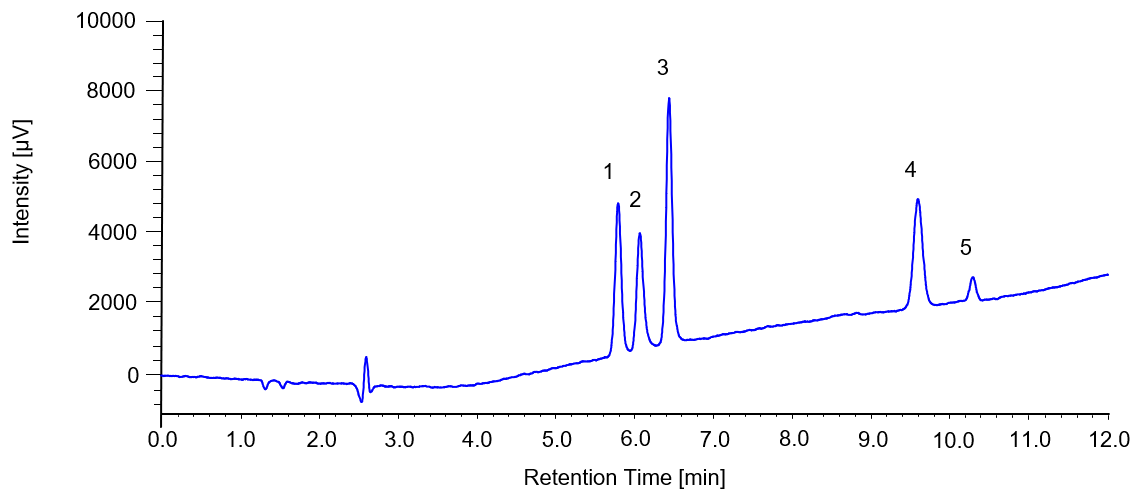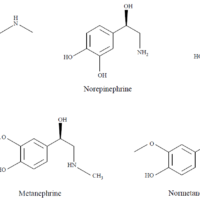Introduction
Water-soluble vitamins complement the functions of enzymes that are required for the metabolism in human body. They must be taken from foods as they are hardly be synthesized in the body. In recent years, growing health consciousness has driven the prevailance of many commercial products containing vitamins as nutritionally functional foods, making Vitamines to attract public attention as functional ingredients.
UV detectors and fluorescence detectors are often used to detect water-soluble vitamins; however, some vitamines like biotin, which barely absorbs UV, have to be detected using short-wavelength UV. Consequently, the measurement of actual samples containing impurities is expected to be extremely difficult due to the interference from the impurities.
Here, we demonstrate the measurement of five water-soluble vitamin components including biotin using the electrochemical detector ED743 manufactured by GL Sciences.
Experimental
[Conditions]
Column: Unifinepak C18 (4.6 mm I.D. x 150 mm L, 5 µm)
Eluent A: 5 mM 1-pentanesulfonic acid sodium and 0.1 % phosphoric acid in water
Eluent B: 5 mM 1-pentanesulfonic acid sodium and 0.1 % phosphoric acid in acetonitrile/water (80/20)
Gradient: A/B = 95/5 (0.00 min) –> 60/40 (12.00 min) –> 95/5 (12.10 min), 1cycle; 21 min
Flow rate: 1.0 mL/min
Column temp.: 40 ºC
ECD condition: 1600 mV vs. Ag/AgCl (Diamond Electrode)
Injection volume: 10 µL
Standard: Cyanocobalamine, Pyridoxal, Pyridoxamine, Pyridoxine, Biotin (Refer to the each data for concentrations.)
[Structures]

Keywords
Water-soluble vitamins, Unifinepak C18, HPLC, electrochemical detector
Results
Figure 1 shows chromatograms measuring standard samples of water-soluble vitamins. Five components were successfully separated and detected.

Fig. 1 A chromatogram of standard sample of water-soluble vitamins (50-1000 ng/mL)
1: Pyridoxal, 2: Pyridoxamine, 3: Pyridoxine, 4: Cyanocobalamine, 5: Biotin
Table 1 shows the results of calculation for the linearity, reproducibility, as well as lower limit of detection and quantification for the standard samples of water-soluble vitamins. Figure 2 shows a calibration curve, confirming good linearity, reproducibility, and detection sensitivity for each water-soluble vitamin.
Table 1 Linearity, Reproducibility, Detection Limits and Limit of Quantitation
| Types of Catecholamines | Linearity (r) *1 | Relative Standard Deviation [%] (n = 6)*2 | Detection Limits*2 [pg] (S/N = 3) | Limit of Quantitation*2 [pg] (S/N = 10) | |
| Retention Time | Peak Area | ||||
| Pyridoxal | 0.9999 | 0.12 | 0.31 | 38.5 | 128.3 |
| Pyridoxamine | 1.0000 | 0.12 | 1.48 | 43.1 | 143.7 |
| Pyridoxine | 0.9999 | 0.10 | 1.59 | 34.2 | 113.8 |
| Cyanocobalamine | 1.0000 | 0.02 | 1.56 | 93.1 | 310.4 |
| Biotin | 0.9999 | 0.03 | 0.39 | 36.7 | 122.2 |
*1 Range of calibration curves: 50-1000 ng/mL
*2 Calculated from the measurement for each standard solution at 100 ng/mL

Fig. 2 Calibration curves of 5 water-soluble vitamin components (each 50-1000 ng/mL)
As a reference, Figure 3 shows a chromatogram for the standard sample of water-soluble vitamins detected by a UV detector (UV-4075) under a similar analytical condition. Table 2 shows a comparison of sensitivities between the electrochemical and UV detectors. The electrochemical detector provided more than 20 times higher sensitivity for all the five components, with more than 200 times higher sensitivity for biotin.

Fig. 3 UV Chromatography of standard samples of water-soluble vitamins (each 1000 ng/mL, 210 nm)
1: Pyridoxal, 2: Pyridoxamine, 3: Pyridoxine, 4: Cyanocobalamine, 5: Biotin
| Pyridoxal | Pyridoxamine | Pyridoxine | Cyanocobalamine | Biotin | |
| Electrochemical Detector, Detection Limits [pg] | 38.5 | 43.1 | 34.2 | 93.1 | 36.7 |
| UV Detector, Detection Limits [pg] | 1340 | 1730 | 829 | 1880 | 8400 |
| Sensitivity Comparison
UV Detector / Electrochemical Detector |
34.8 | 40.2 | 24.3 | 20.2 | 229 |






